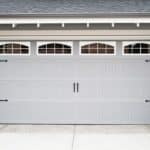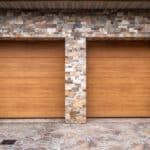Your garage is a safe harbor for your car after you’ve come from work or the McDonald’s drive-through. Tools and other equipment can also be kept in the garage. A garage is generally a great organizational and protective space.
OK, so maybe you don’t keep your car or tools in the garage. Perhaps the space is stuffed full of boxes from a recent move, or is even a converted room. Regardless, whatever you’ve got in there is kept safely out of the way.
The garage isn’t the one doing all the heavy lifting, though. Garage doors keep sunlight and other harsh weather from damaging your vehicle. These doors also stop people from potentially harming your stored items.
But where did the idea of garage doors come from? It may seem like an obvious solution to add a door where your car is to keep the snow away, but history demonstrates that’s not the case.
If you’ve ever wondered about the history of garage doors, you’re in luck. This article will discuss garage door history and its evolution throughout the decades.
What Are Carriage Houses?
The 1700s were when horse-drawn carriages were at their most popular. Owning a carriage was a sign of wealth and affluence among the British upper class. As a result, the demand for ways to protect their carriages grew.
These protective measures – carriage houses – first appeared in Great Britain in the 1700s and made their way to the United States in the mid to late 1800s. Carriage houses are a common sight in New York and New England.
There are four common characteristics that carriage houses share regardless of location. These tiny houses were typically two stories, and the first level is where the carriage was stored.
Carriages weren’t small, so the first story was open and had high ceilings. The second characteristic is the living quarters. The second story of carriage houses is where the driver and groomsman lived.
Some of these tiny houses also had stables for the horse. The third characteristic is that carriage houses were standalone buildings. Unlike the modern garage, they weren’t attached to the home.
The fourth and final common characteristic of a carriage house is its design, or rather, how similar they look to the main house. People built carriage houses to mimic the home’s look on their property.
Many homeowners renovate carriage houses into modernized garages and smaller guest accommodations. You could remodel a carriage house into a fully functional home if you wanted.
While a newly renovated carriage house would have lovely, functional doors to suit its assigned purpose, older houses had swinging doors. However, these doors weren’t too sturdy and tended to fall off their hinges.
Where Did People Put Their Cars?
Not everyone had a carriage house for their vehicles. Some people ended up putting their carriages in their barns. Others that had carriage houses didn’t have a separate compartment for the horse.
Cars and house-drawn carriages coexisted for quite a long time. When cars first arrived on the scene, owners realized they had the same problem with their carriages. The automobiles needed somewhere to be stored.
The earliest versions of cars usually didn’t have roofs. People needed to find a place to keep them out of the elements and prevent damage. Carriage houses came to the rescue once again.
At first, it made sense to keep your car in the small outbuildings on their land. “Carriage houses” were specifically houses to keep your carriage, i.e., your mode of transportation.
Because cars were the newest way to travel, their owners also put them alongside carriages and horses. There was a problem with keeping cars in the carriage house, though – namely, the smell.
Horse manure, as you might imagine, doesn’t smell too fantastic. It’s not too surprising that car owners (especially the more wealthy ones) didn’t want their new vehicles smelling like animal droppings.
Birth of the Garage
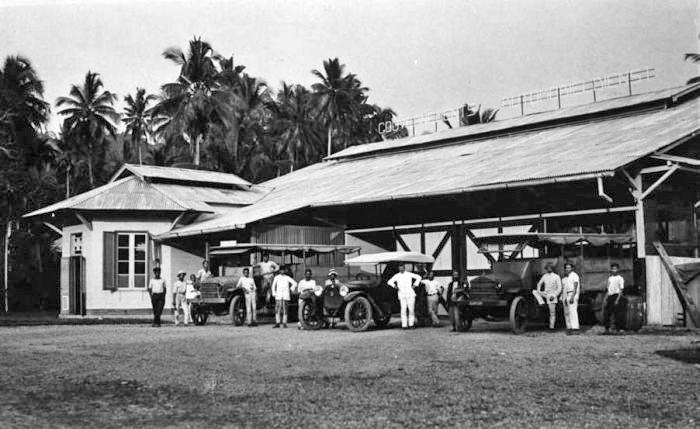
The desire to have non-foul-smelling cars necessitated another solution. Garages started popping up some time at the start of the 20th century. These prototype garages weren’t like what we’re used to.
Early garages were a public affair. They were more like public parking lots than the attached compartments to homeowners’ residences. These garages were large and could store multiple vehicles at once.
Some of these storage facilities were publicly owned, and others belonged to private owners. The business was rather profitable as there was a monthly charge of about $15 to $20 to keep vehicles stored in these locations.
If you were a car owner that kept your automobile in a public garage, there’d be about 100 other vehicles alongside yours. The garages were heated and maintained by the owners.
Public garages probably weren’t too bad a deal. The problems started when there were too many cars to meet storage demands. Technically, the most famous iteration of old-style automobiles came about in 1908.
Once the Model-T’s popularity took off, everyone wanted a car. By the time 1910 came, public garages were not sustainable. So, people had to reevaluate the carriage house idea.
Sticking Close to Home
Here is where we begin to get into the grit of garage door history. People realized that despite the smell, carriage houses worked perfectly fine. They didn’t use the carriage houses again, though.
Many people didn’t have these buggy storage outhouses. Remember – horse-drawn carriages were a sign of affluence. Cars were affordable enough that middle-class people could own one. People built new outbuildings instead.
These simplistic buildings had garage doors. But like the original carriage house doors, the ones for garages weren’t too great either. The first proper home garage doors were more like barn doors.
At this point in garage door history, these outbuildings had double doors attached to strap hinges. Strap hinges have two flat triangular-shaped pieces, where one flap fastens to the door and the other to the adjacent wall.
The strap hinges allow the doors to open outward but couldn’t withstand much long-term use. Over time, constant opening and closing wore down garage doors and the hinges, eventually failing.
Classic garage doors didn’t do that well in snowy or windy weather, either. The outward opening function was troublesome as the snow would block the entrance. When it got windy enough, the doors would close shut.
Modifying the Garage Door
Double doors weren’t as effective as car owners would have liked. The entire purpose of having garages on their property was convenience. Garage doors had to accommodate this desire.
The continuing evolution of garage doors eventually led to builders adding sliding tracks. The idea was the doors would slide open and close regardless of what was in the entryway.
Sliding garage doors also took less space than the older double door design as they stayed within the confines of the storage space. There was a problem with sliding garage doors as well, though. The garage itself had to be huge.
Because these newer entrances slid open and off to the side, garages needed to be twice as big as the doors. Sliding tracks were a good try, but there still had to be a better way. It was someone else’s turn to improve garage doors.
The Garage Door Is Born
C.G. Johnson recognized the inherent issues with garage doors and decided to create his own. In 1921, Johnson patented overhead garage doors. It’s no over-exaggeration to say this was one of the best inventions for the garage.
The first overhead doors were placed away behind garage entry corners, so technically, they weren’t overhead doors but rather foldaway. It wasn’t until later that genuine overhead doors that folded to the ceiling existed.
Overhead or up-and-over garage doors are cut into sections and hinged at the cut intervals. The attached hinge portions let homeowners tuck the overhead doors away, allowing smaller garages.

Garage Door History Moves Forward
Johnson came up with another revolutionary invention in 1926. Some people were having issues lifting the heavy up-and-over doors. To that end, Johnson created the electric door opener to relieve customers’ hefty burden.
This further evolution of garage doors also started the Overhead Door Corporation, and the garage door industry began booming. Wayne-Dalton is another business that rose to meet consumer demand for overhead doors.
Everyone Wanted a Garage
When 1925 rolled around, everyone decided they wanted a garage. Real estate agents began to report that properties didn’t sell unless there was a garage on the premises. However, garage space eventually ran low.
C.G. Johnson resolved the “garage size problem,” but now there wasn’t much space for garages regardless of size. Between the 20s and 30s, room was at a premium. Architects added garages to homes at the start of the 1940s.
The newly incorporated design made garages more convenient and functional for homeowners. People could enter and exit their garages from their homes and the garage door.
Now that garages became integral parts of houses, people wanted some style with the substance. People requested that contractors build various types of garages. Ultimately, homeowners had a few preferred styles.
The Mediterranean and French-style houses and garages were popular among homeowners. Craftsman, Colonial, and Old English were among the preferred kinds of homes and garages people wanted also.
Americans expected that garage doors match the numerous styles they wanted their homes to have. The doors had to work and needed to look good too. The aesthetic requirement was a boon for the garage door industry.
Interestingly, garages began to become larger again during the 1960s. More families could afford two cars, so garages needed to be more expensive. The garage was almost half a house’s square footage in the 60s.
Garage Door Materials
Throughout most of garage door history, they’d been made of wood. The problem with wooden garage doors, though, is that they’re vulnerable to the weather. Sun warps wood, and rain would eventually rot the doors.
Painting the doors was a potential protective measure. Scraping away splintered pieces of wood was also an effective way to preserve garage doors. However, homeowners would likely need a replacement.
The continuing evolution of garage doors demanded that technology find better alternatives to wood. Luckily technology was able to deliver on those alternate materials. Galvanized steel was the first new sort of door.
Galvanized steel is a variation of steel (or iron) coated with zinc to prevent oxidization. Garage door manufacturers caught on to galvanized steel’s usefulness in the 1970s. There were problems with steel doors, though.
Steel is a poor insulator, especially compared to wood. The companies building garage doors managed to find a workaround for steel’s poor insulation.
The solution was relatively simple. Manufactures would take two pieces of steel and apply polystyrene between them. The added styrofoam layer helped keep garages warm during the winter and helped doors last longer.
Fiberglass was another material that found use in garage door making. Unlike galvanized steel, fiberglass is naturally insulating. The material would help keep garages cool in the summer and warm in the winter.
Resin-filled wood was another material used for garage doors. The resin made these newer ones more resistant to damage than the old wooden doors. The final kind of door was aluminum-covered vinyl.
These aluminum garage doors were the easiest to coordinate with homes because contractors already used vinyl on the sides of houses. Creating good curb appeal was more straightforward with vinyl garage doors.
Garage Door Evolutions in Safety
As mentioned earlier, C.G. Johnson created electric openers so people would have an easier time lifting their overhead doors. As with the continuing evolution of garage doors, electrical openers made things convenient.
People could drive up to their garages and press a button so they could enter their homes without ever having to leave their cars. But, like with all the innovations throughout the evolution of garage doors, there was a problem.
The 1970s were a dark time during the history of garage doors. The commonality of overhead garage doors and electric openers created a safety hazard. Specifically, children were attracted to the mechanized entryways.
From the early 70s to the mid-90s, young children were involved in accidents involving electric garage doors. It was easy for kids to access the electric opener. Unfortunately, over 80 children were injured.
Children got caught by the lowering doors and were hurt and sometimes even killed. These accidents caused the United States Consumer Product Safety Commission to decree necessary precautions.
In 1993 a law was written that made photoelectric and pressure-sensitive sensors a requirement on garage doors. Photoelectric detectors use light to sense the presence of anything near an object.
On the other hand, pressure-sensitive sensors can detect when someone applies pressure to them. Photoelectric sensors are mounted six inches away from the garage floor. Pressure sensors go on the bottom of garage doors.
The point of both of these sensors is that they’re supposed to reverse upward if they sense something underneath. However, many sensors didn’t work correctly. There were still incidents where doors still injured children.
Manufacturers continually improved garage door detectors throughout the years to fix the problems. Nowadays, it’s rare to hear of anyone getting hurt by a garage door.
What Is a Portable Garage?
The portable garage is another option to keep the weather away from your car and other valuables. Although portable garages may sound like recent inventions, they’ve been around for a long time.
Portable garages have been around since 1908 when Sears Roebuck or the Sears store franchise sold them in their catalogs. Portable garages were prefabricated and made of wood or metal sheets.
Portable garages are still prefabricated but made with more versatility. You can get a portable garage in whatever shape or size you need. The garages also come in various materials.
You can get ultraviolet-resistant garages and fire-retardant plastic sheeting or tarps applied over metal poles if you prefer. Instant garages are an option too. An instant garage is a plastic sheet draped over metal poles.
Instant garages provide you with about three feet of clearance on all sides of your vehicle. These quick build garages are great when you need to work on your car in the colder months because you inflate them with hot air.
Are Portable Garages Any Good?
A portable garage is more than just a plastic shack that you can shove things underneath. Unlike a carport, portable garages offer protection on all sides, including the front. Yes, portable garages do have doors.
The garage doors on these portable storage areas work much like overhead doors where you’d store them near the top of the room. A portable garage is a viable solution for a homeowner that doesn’t have a garage.
Garage Door Types
Our team is an expert in all things to do with garage doors. So we’re going to give you a quick crash course on the different entrances you can have installed. Below is a list of four types of garage doors.
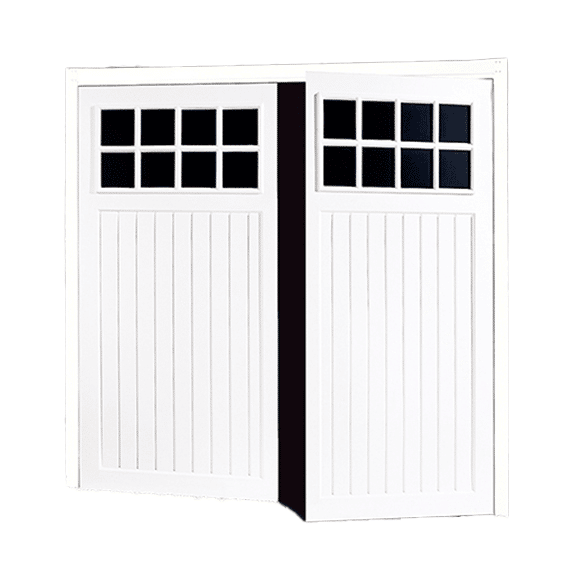
Side-Hinged Doors
History is prone to repeating itself. Although we’ve made many technological advancements throughout the years, sometimes the classics are best. Some people want the old-fashioned feel of carriage houses.
Side-hinged doors are the modern incarnation of the old-style barn doors we’ve already mentioned. The difference between the older barn-style doors is that these modern ones are more durable with automated features.
Manufactures make modern side-hinged doors out of wood or galvanized steel. The distinction between typical modern side-hinged doors and carriage house ones is their decorative features.
Specific places can install carriage house doors made of authentic materials. For example, you can have garage doors made of metal from around a century ago.
Sectional Doors

We’ve already spoken a little about sectional doors. These kinds of garage doors consist of individual panels connected by hinges. Sectional doors are the most popular kind of door in the United States.
Sectional garage doors are opened and closed by wheels attached to a track that winds the entry up or down. High-tension cables keep the door from sliding down when it’s halfway open.
You’ll often find sectional doors are made of steel and don’t require much maintenance. You can have sectional doors customized in various ways, from different colors to adding windows.
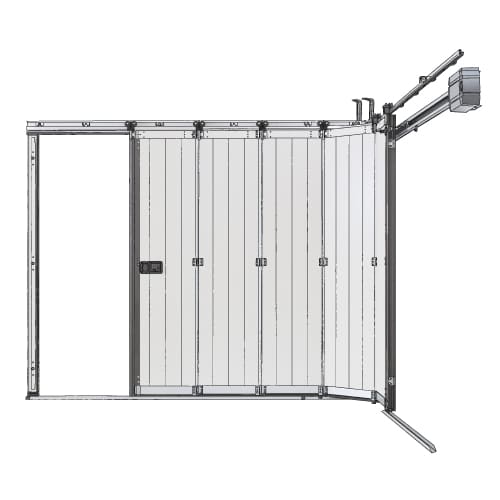
Slide-to-the-Side Doors
Slide-to-the-side doors are similar to the original side folding garage doors over 100 years ago. Slide-to-the-side doors are mounted parallel to a sidewall and are best for garages with low ceilings.
Side sliding doors run on-wall-mounted trollies that can flex with small slopes in a garage floor or ceiling. Because the doors are attached to the wall, there’s no need for a ceiling-mounted motor.
Tilt-Up and Over Retractable Doors
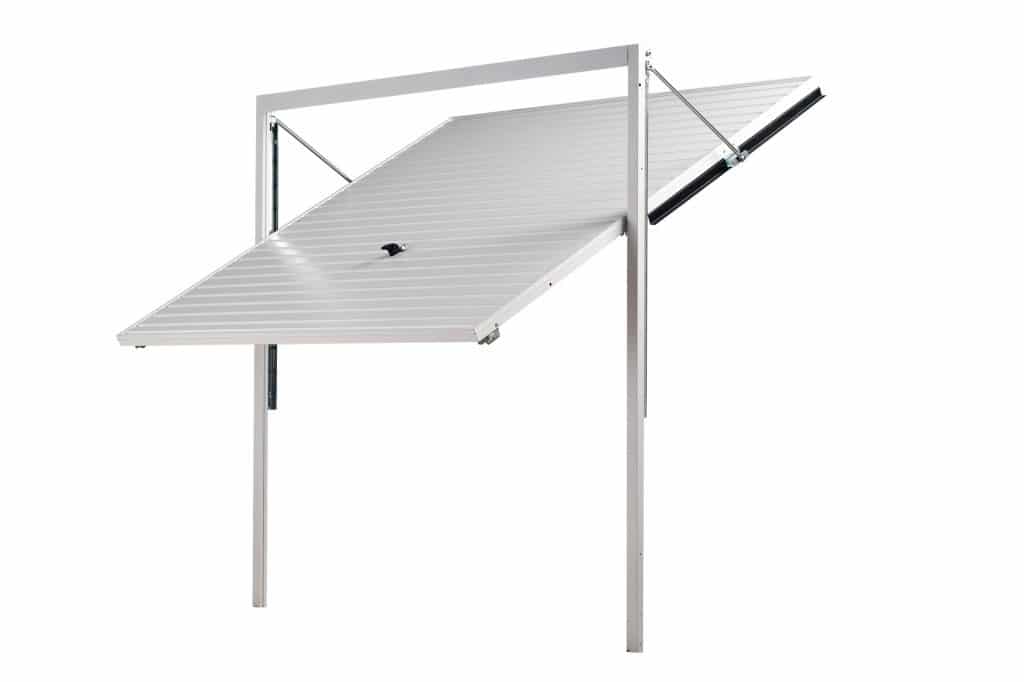
Tilt-up and over retractable doors lift away from their metal frame. They don’t extend past the front of your house when lifting into the ceiling. Tilt-up and over retractable doors require more garage space than usual.
While choosing your garage doors is up to personal preference, you should know that this kind of door can be challenging to use. Tilt-up garage doors are also more expensive than other options on this list.
Looking for the Perfect Garage Door?
Garages and garage doors have a long history of over a century. Although garages have technically existed since 1908, they didn’t become popular until people created the first public ones.
You could argue that the first garage doors existed with the invention of carriage houses, even though people used them for horse-drawn carriages. From there, garage door evolution provided various innovations.
OGD™ Overhead Garage Door provides many garage door-related services, from repair to installation. If you’re looking to install an overhead door, contact us here for more information.

